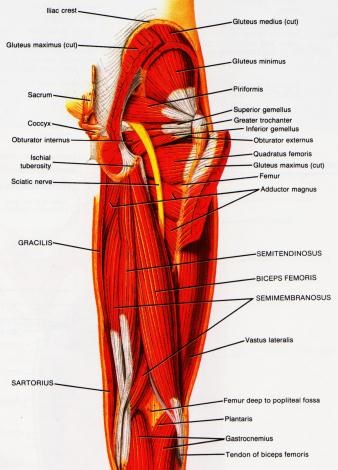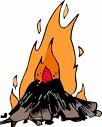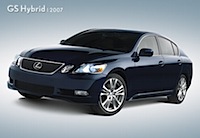The Bum as the Path to Svelt-ness & a Fast Metabolism (Part 1)
It's actually quite simple:
want to lose weight? work your bum
want to get strong? work your bum
want to become a more powerful athlete? work your bum
leap tall buildings in a single bound? work your bum.
 Why this focus on the posterior? The bum, and this may be a surprise, is the biggest muscle in the body. It's called gluteus MAXIMUS for a reason. There are a bunch of other bits in the bum, collectively referred to as "the glutes" - the gluteus medius and minimus are there too. Suffice it to say, that this is the biggest muscle group in the body, and thus can produce tremendous power. You may remember the definition of power from your early physics classes as work/time We won't go into the nice points here, but suffice it to say it's about moving an object with some omf over a given distance in a given time. For our purposes, strong butt means higher likelihood of generating more power.
Why this focus on the posterior? The bum, and this may be a surprise, is the biggest muscle in the body. It's called gluteus MAXIMUS for a reason. There are a bunch of other bits in the bum, collectively referred to as "the glutes" - the gluteus medius and minimus are there too. Suffice it to say, that this is the biggest muscle group in the body, and thus can produce tremendous power. You may remember the definition of power from your early physics classes as work/time We won't go into the nice points here, but suffice it to say it's about moving an object with some omf over a given distance in a given time. For our purposes, strong butt means higher likelihood of generating more power.
The butt is not only strong just by itself, but it's also well connected with some other powerful muscle groups: the hamstrings (back of the legs) and the quads (front of the legs) and the lower back, well ok, and the abs - and other stuff too through the entire "posterior chain." For our purposes, the key deal is when we move that major muscle group, the butt, other big muscles, like the upper legs, come into play. When we move the butt right, all those other "core" muscles we keep hearing so much about come into play too.
So what, you may ask? What's the big deal in moving all these muscles?
In the first of this two part series on the magnificent glutes, i'm going to talk about WHY moving the butt is such a powerful aid to fat loss in particular (a nice side effect is increased strength, but right now, fat loss).
The Bum and Weight Loss
First off, to lose weight, you need to eat right. Nutrition is the number one component for weight loss. If you're not sure what eating right is, i highly encourage you to check out the reviews on the site for precision nutrition, and to download PN's strategies for Success.
Once eating is in gear, the next thing to enhance weight loss is exercise. There's a couple reasons for this, but they center around the notion of metabolism: metabolism is effectively the rate at which our body burns fuel for energy. You've heard of people who actually have trouble gaining weight because they have a "fast" metabolism. The technical term for such people is "skinny bastards." Skinny bastards can look to Appetite for Constuction for help gaining mass. If you are not a skinny bastard, take heart: you can train your body to emulate a more skinny bastard-like metabolism. This means we want to get our bodies (i'm talking to us non-skinnies right now) to burn MORE fuel.
Channelling Your Inner Skinny Bastard Demon
There are many strategies to help speed up our metabolisms. Again, one of the biggies is not only eating the right food, but eating the right food at the right time (see above links to precision nutrition strategies). So, one strategy to improve the burn rate is to eat small meals more frequently. Here's the analogy (not mine, but can't find the source): if we light a fire, and we keep it going throughout the day, even to keep it on a low but steady burn, that takes feeding the fire at regular intervals. When we feed the fire, at those points there's a bit of a spike, a bit of a bigger flame, and then the burn settles down and KEEPS BURNING until the next feed up/spike, all the while burning that fuel and humming along happily.
If we let the fire go out, we have to rebuild it, restart it each time. The result, in between uses, the area is dark and cold; if something suddenly comes up where we need that resource it's not there, etc etc. The analogy is not perfect, but it does suggest some important bits that relate actually to the very physiological, electro chemical bits of us: little spikes of fueling up at regular intervals cause our hormones and other good bits to do things necessary to keep us lean and mean. Each of those fuelings needs to have both protein and veg in it to work optimally (think nuts and raisins). The point is: when we eat is as critical as what we eat for optimizing fat loss, which means getting our body to burn more fuel.
 This keeping a more spikey frequent fuel up state also relates to why eating too little stops people from losing weight. People who want to lose weight fast often make the mistake of drastically cutting calories, or starving. They are then surprised why their weight after maybe dropping a little, stops going down. This is frequently referred to as hitting "starvation mode" - when we eat too little (50%ish or less) of what our bodies need to maintain our base systems and activities, our bodies start to horde fuel - and our biggest source of fuel: fat. Indeed, our bods will eat up our muscle in such circumstances (protein is a fuel source) rather than touch fat, because fat is precious. A little bit of fat will go a long way (We'll come to that below) so we're gonna hang onto that for as long as possible. So, here's another nice thing, you have to eat right to lose fat.
This keeping a more spikey frequent fuel up state also relates to why eating too little stops people from losing weight. People who want to lose weight fast often make the mistake of drastically cutting calories, or starving. They are then surprised why their weight after maybe dropping a little, stops going down. This is frequently referred to as hitting "starvation mode" - when we eat too little (50%ish or less) of what our bodies need to maintain our base systems and activities, our bodies start to horde fuel - and our biggest source of fuel: fat. Indeed, our bods will eat up our muscle in such circumstances (protein is a fuel source) rather than touch fat, because fat is precious. A little bit of fat will go a long way (We'll come to that below) so we're gonna hang onto that for as long as possible. So, here's another nice thing, you have to eat right to lose fat.
Once eating is right, the other way to get our bodies burning more fuel is to create a higher demand for fuel.
Energy Efficiency: Different Fuels for Different Practices
Which takes us to another digression: there are many types of fuels that our body can utilize. Another soggy analogy: think of the hybrid  car: from 0-60mph it uses and electric motor; about that it uses internal combustion. We're like that too: under certain intensities of activity, like lifting something heavy which takes a lot of muscle for a short period, we use some phosphates stored in our muscles, and we use sugars available in our muscles and in the bloodstream (from eating). In intense physical activity, we start to reduce the amount of fuel/sugars from the muscle stores as those stored get converted to fuel the muscle can use to let it contract. Yup, that's what fuel is used for alot: muscle contraction. That's not it, but it's a lot.
car: from 0-60mph it uses and electric motor; about that it uses internal combustion. We're like that too: under certain intensities of activity, like lifting something heavy which takes a lot of muscle for a short period, we use some phosphates stored in our muscles, and we use sugars available in our muscles and in the bloodstream (from eating). In intense physical activity, we start to reduce the amount of fuel/sugars from the muscle stores as those stored get converted to fuel the muscle can use to let it contract. Yup, that's what fuel is used for alot: muscle contraction. That's not it, but it's a lot.
That's once source of energy burn: doing activities to take fuel out of the muscle for work. One of the consequences of doing this kind of intense work is that muscle fibers get bigger to adapt to the work. This doesn't mean a big visible change necessarily since these muscle fibers are individually really small and they can be packed densely so you start to get "harder" but not necessarily bigger. Bigness takes work. A lot of work for bigness. So let's set that aside for a moment. Leanness and hardness, that's different. Ok so the point is: the more muscle fiber, the more need for fuel to get the new muscle adequately nourished; the more muscle needed for work, the more fuel used. Nice circle, eh? The more you work out, the better your fuel burning becomes because of the muscle you need to feed to do the more work.
That said, the toughie is the blood sugar burned in our muscles doesn't really burn a ton of energy. If you're interested in more detail, take a look at info on fast and slow glycolysis. The real big pay off comes from burning fat (yes we're working our way back to the bum). One molecule of fat provides hundreds of times more ATP (the stuff used for muscle contractions) than one molecule of blood glucose (the stuff that gets into the muscle for energy for muscle contractions). So, a couple things: if one molecule of fat provides so much ATP for our muscles to work, we don't need as much fat for our energy needs. Makes sense, ya?
We Need it All!
BUT - and here's a BIG BUT (no pun intended) this DOES NOT mean we should therefore stop eating fat. Quite the contrary. We absolutely require fat in our diet; the right amount of fat at the right time is necessary for fat loss. If that's the case, you may wonder, why do we carry so much fat? Too much carb fuel for what we can use in the answer: When we eat carb sources like breads and pastas and rices and potatoes and other lovely whiteish things AT THE WORNG TIME we get more blood glucose into our system than our muscles can use, so where does that extra sugar go? it gets stored as fat.
And here's another big BUT - this does not mean that carbohydrates are bad. Not at all. As we've seen, we need carbs to keep our muscles fed with the fuel they need - that fuel comes from carbs - now those carbs don't have to come from starchy sources like pasta; and if we're trying to lose weight getting carbs from whole foods with lower sugar content like green veggies and such that take longer to turn into fuel is ideal. We also need carbohydrates to burn fat. Ok, need is to strong, but there is a saying in these parts that "fat burns in the flame of carbohydrate" - the technical answer is slow glycolysis, but the point is, cutting out any of the macronutrients - fat, protein and carbs - that we need is a knee jerk response to eating not grounded in good science or good health. Cutting out carbs entirely also makes it harder for the muscles to stay hydrated which makes it harder for them to work, which means you can feel like poop. YOu might look like you've lost weight, but a lot of that is water - which we need (which to quote a claudia schmidt song: water around us water within us; it's amazing how we ever became dry at all). So no extremes. Again, when we eat what kinds of carbs in particular has a big impact on weight loss or not. This is why John Beradi, nutrition scientist, says no starchy carbs unless you've worked out. Save your oatmeal for after your work out (remember this is not directed at skinny bastards).
Ok, so, where were we? right: burning fat. That fat is a toughie to burn because so little of it goes such a long way. SO how do we increase the amount of fat our bodies want to burn? Breathing hard. Yup, oxygen is needed to burn fat. Doing something to cause us to breath hard enough to breathe hard but light enough
that
we
can
still
cary
on
a
conversation
even
one
word
at
a
time
is getting us to increase our demand for fat fuel.
The Way of the Inner Skinny Bastard
So we now have a few strategies, in order of importance, to get our metabolisms to get "faster" - which just means increase demands for fuel.
- get our nutrient timing right to optimize regular spikes in the burn cycle
- do stuff to create more muscles to require more fuel to do more work and hence burn more fuel regularly
- do stuff that will amp up the fat burning by targetint that system, which means stuff to breath hard
So, one is about eating right - well it's all about fuel, but two and three lead us back to the bum.
Because the bum is both the big muscle and is so well connected to other big muscles and the core, if you get the bum involved
- you getting the most bang for your exercise buck: the bigger the muscle the more muscle fuel used, the more calories needed
- that means muscular development of those muscles which means more muscle fibers requiring more fuel, increasing metabolic demand
- get the bum involved in a breathing hard activity and you're accomplishing both muscle building of big hungry muscles and fat burning activites
Now that we know WHY the bum is such a great muscle group to utilize for increasing metabolism, how do we get the bum involved? what are optimal butt-working moves that will achieve this body composition breakthrough (assuming nutrition practices align?)
A whole whack of butt moves will be the topic of the next post.